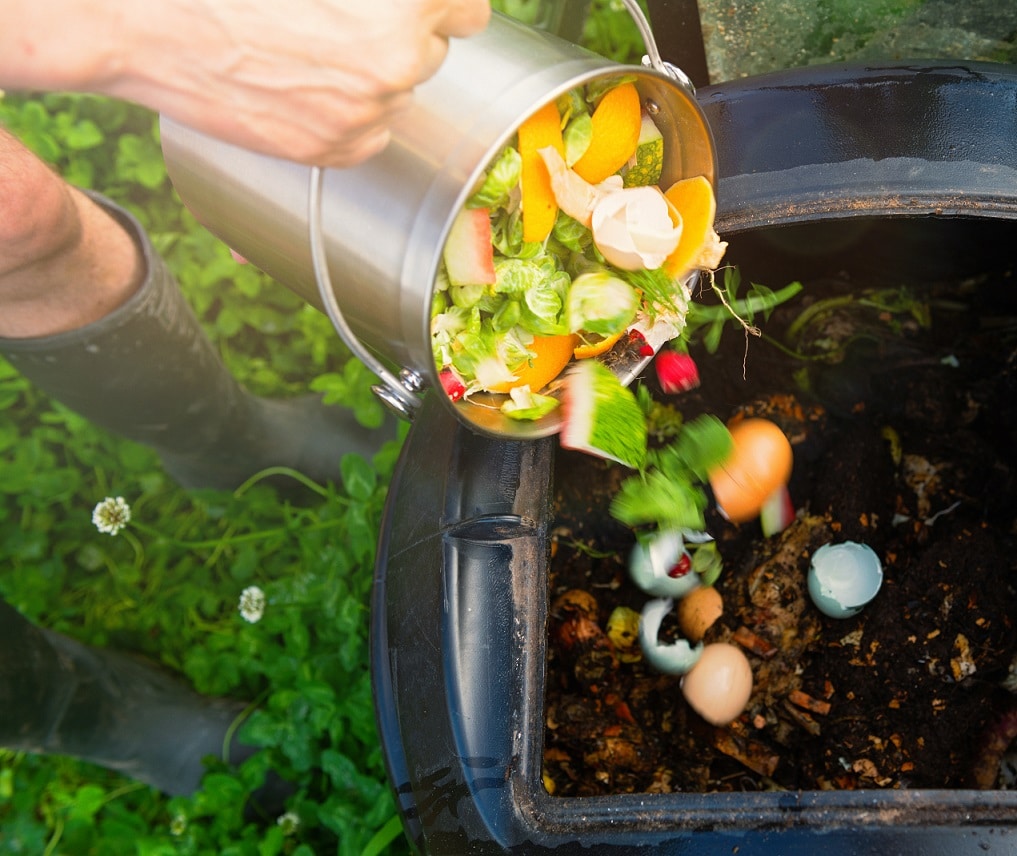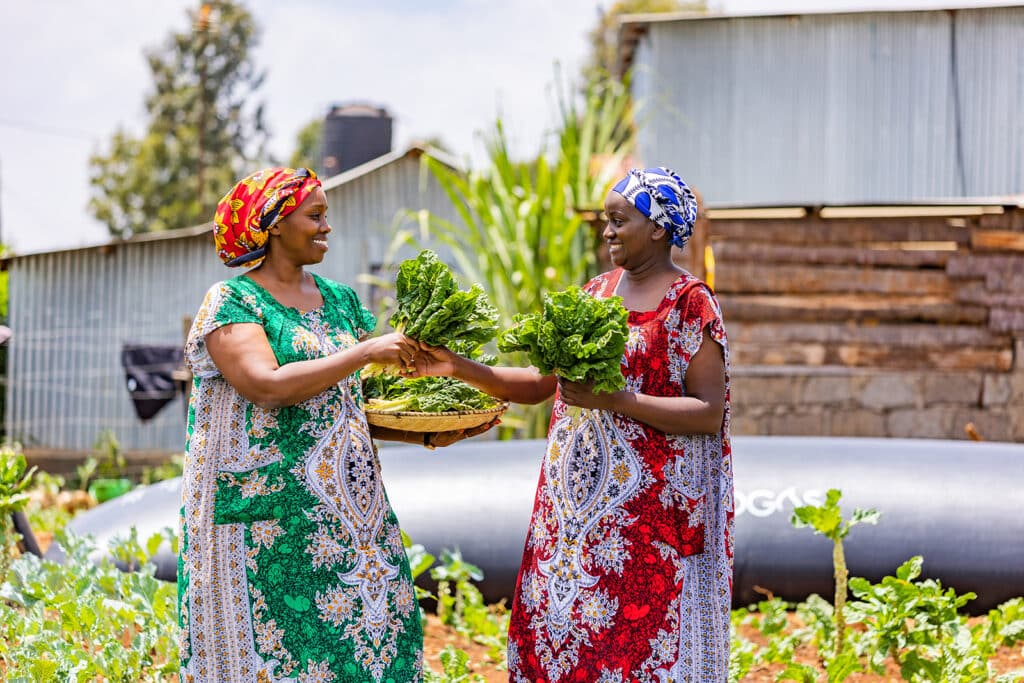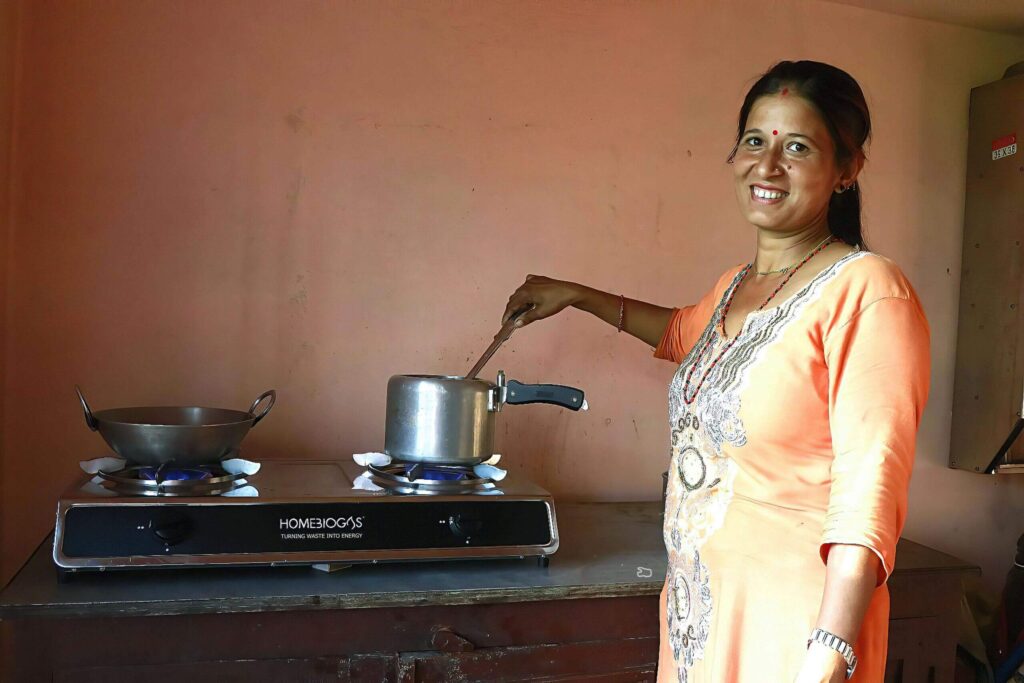
Compost Bins: Characteristics and Usage
A compost bin is a container that provides the proper environmental conditions for organic matter to decompose and become compost. It attracts microscopic organisms like bacteria and fungi, which disintegrate the organic materials, such as garden and kitchen waste, and release nutrients beneficial to the soil and plants.
A suitable compost bin plays a double role:
- It keeps materials close together so they can generate heat and accelerate the composting process.
- It enables aeration to provide the microorganisms with enough oxygen to thrive.
Compost bins often require a lid that keeps away excessive rain that can slow down the decomposition. On the other hand, these containers are usually open or come with an additional compartment at the bottom for easy compost harvesting.
Bottomless bins have the advantage that organic matter can be in direct contact with the soil — this way, bacteria can reach the waste easily and start the decomposition process.
It’s important to note that an appropriate ratio of green and brown elements (1:2) is necessary to start the composting process. You also need to add water and aerate to ensure that bacteria have everything they need in the right quantities to decompose the organic matter into compost gradually.
3 Types of Composting in a Bin
1) Continuous composting
Continuous compost bins can take in the new organic matter at any time, as their design enables an ongoing process so you can harvest from the bottom even if the layers in the top aren’t composted yet. They have multiple chambers:
- One at the top, where you can place fresh organic matter
- A middle section where the primary composting process takes place
- A maturation chamber at the bottom where the composted material drops when the decomposition is almost complete
A lid is necessary to keep rodents and other animals away from the organic waste. Most of these containers are bottomless. The compost settles here, and you can easily collect it.
2) Batch composting
Batch composting means filling the container at once instead of adding ingredients continuously. Each batch begins with the right mixture of components and cooks until the decomposition process is completed.
It’s a faster method to obtain compost, but it requires daily interventions for mixing the ingredients and monitoring the moisture level inside the bin.
3) Worm composting
Worm bins are similar to plastic containers in which you add worms and soil to help you break down food waste to obtain compost. These systems work best when kept indoors to protect the worms from extreme temperatures. Worm compost bins are structured similarly to continuous compost bins — multiple chambers that separate the materials inside.
Red wrigglers are the best worms for the job, as they can quickly consume large amounts of food scraps. For maintenance, you must regularly scoop the liquid from the lower container.

Compost Bin vs. Compost Tumbler: What’s the Difference?
Both compost bins and tumblers serve for producing compost – tumblers are often called compost bins. However, they’re different products with noticeable distinctions:
- A compost tumbler is a fully sealed container, while the compost bin is usually open at the bottom.
- The bin must have a fixed position because of its opened bottom, while the tumbler can be rotated to mix the composting materials.
- Tumblers have a relatively small capacity.
- Tumblers accelerate the composting process.
- Compost bins are more difficult to empty than tumblers.
How to Select the Size of the Compost Bin?
Consider the practical aspects of your household before picking the proper size compost bin:
- The available space. The size of a bin you can place in your backyard will differ from one for composting in an apartment.
- The amount of compost you need. Consider that the organic matter inside the bin will heat up and gradually shrink to no more than half its initial height as the materials break down — according to studies, the volume of the pile can decrease by 70 to 80%.
- Your lifestyle. The amount of organic waste your household produces will also influence the bin’s size. For example, a small compost bin isn’t enough if you need to manage significant amounts of garden waste.
You can also consider having multiple bins containing compost in various phases, so you always have a “fresh” bin and ready-to-use compost available.
How to Start a Compost Bin
Composting at home requires a container and organic materials.
Compost bins are available in local and online stores, but you can also build one from two buckets, an old trash can, or other plastic or metal containers.
If you opt for a DIY project, make sure your compost bin has the following elements:
- A cover to keep insects away
- Holes (covered with screen fabric) to provide ventilation and oxygen for microorganisms responsible for composting.
Once you have the bin, all you have to do is fill it with:
- Brown ingredients, like coffee grounds, coffee filters, hay, fall leaves, chipped branches, peat moss, paper plates, napkins, and other similar organic materials.
- Green ingredients, like tea bags, seaweed, cow, horse, chicken manure, grass clippings, and weeds without seeds.
Shredding the waste before placing it in the compost bin is extremely helpful, especially for more rigid brown materials like twigs and sticks. Not only will this facilitate the “turning” or mixing process, but it will also increase the organic material’s surface area, accelerating the work of microbes.
Ideally, for each layer of green elements, you add two layers of carbon-rich materials to maintain the correct carbon: nitrogen ratio inside the bin. Don’t add meat or dairy items because they deteriorate and draw bugs. Pet waste can transmit diseases and doesn’t belong in the compost bin.
It’s essential to control the moisture level and adjust the green-to-brown ratio. Furthermore, you want to turn the content in the bin periodically to supply oxygen and maintain your compost aerated.
How do you know it’s ready to harvest? Compost typically crumbles in your hand, has an earthy smell, and has a deep dark brown color. The process isn’t complete if you can still see recognizable food content or the mix is warm.
Compost Bins and Anaerobic Digestion
Traditionally composting occurs in the presence of oxygen — the process is called aerobic digestion. On the other hand, anaerobic composting is a process that occurs in a sealed environment in the absence of oxygen.
Both are biological processes that produce solid, liquid, and gaseous components:
- Aerobic composting results in compost, water, and volatilized gases are all products of aerobic composting — primarily ammonia and carbon dioxide.
- Anaerobic digestion produces biogas and digestate, which is a nutrient-rich substance.
Anaerobic composting takes longer than conventional composting and involves different types of bacteria. It’s a natural process that you can easily replicate at home. Something as simple as a plastic bag filled with organic kitchen waste and placed in the sun can be considered an anaerobic composter.
If you want to build a simple anaerobic compost bin, you can use a single-compartment container that is either partially buried in the ground or sealed. Sometimes, it can also have a small tank underneath where you can collect the compost.
If you decide to use a trash can for this process, you only need to drill a few drainage holes in the bottom — but you won’t need the air holes anymore. Then, except while you are adding material, keep the container tightly sealed.
Anaerobic digestion produces an unpleasant smell, but since you close the bin, it shouldn’t cause problems.
Alternatively, you can opt for more complex biogas systems that enable you to produce and use the biogas resulting from the process. In this case, you use a larger digester, gas pipes, filters, and even a biogas stove so you can use the fuel for cooking or heating.
A Word on Bokashi Composting
Bokashi composting comes from the Japanese word “Bokashi,” which means “fermented organic matter.” It’s an anaerobic method that uses an inoculant typically based on sawdust, wheat germ, or wheat bran with molasses and microbes. These microorganisms are naturally found in soil and feed on molasses.
The concept is similar to conventional composting. You must layer kitchen scraps with the inoculant in a bucket with an airtight lid. Furthermore, you can press the food waste into the composter to remove as much air as possible from the container.
The advantage is that you can compost all food waste, including vegetables and fruits, meat, and dairy scraps. Plus, the process lasts around ten days — faster than traditional composting.
You can create a DIY system or purchase Bokashi composting kits online or from garden supply stores specializing in natural living items. These stores also sell replenishment products you need to keep your microorganisms alive.
The Bokashi bucket has a faucet at the bottom to drain the generated liquid. This “Bokashi tea” is nutrient-rich fertilizer for your garden or houseplants.
What to Pay Attention to When Selecting the Best Compost Bins?
1) Usability
The best compost bins are resistant enough to keep things inside and large enough to allow you to turn the compost using a shovel or pitchfork. This second part is a little challenging in practice, as bins make it hard to aerate materials with a shovel. So, very often, you’ll have to leave the compost unturned — which slows down the process significantly.
As for harvesting the compost, gardeners will often remove the entire container of the compost and then separate the composted layers from the incomplete compost. Then, they use a shovel to put the organic matter back into the bin, where it can complete the composting process.
2) Durability
Since compost bins have the purpose of holding the organic matter for composting and do not support any weight, they are often made of thinner plastic, which can become brittle with time. These bins are lightweight and cheap, but they’re usually easy to break and may become difficult to clean over time.
Heavy-duty plastic and stainless steel are better choices and more likely to resist cold weather and prolonged exposure to sunlight while being light enough for you to carry around your backyard as needed.
3) Volume
Analyze how much organic waste you produce per week and month before you select the proper compost bin. Think of all the activities that can influence the amount of waste, such as cooking or gardening.
Consider that composting can take anything from a year or more to as little as six to eight weeks — depending on the work you put into it. If you can monitor your bin and wish to accelerate the process, pick a small container and do several batches of compost a year.
4) Ventilation
A compost bin should generally have holes every 4 to 6 inches (10 to 15 cm) and a significant number of holes in its foundation if it’s not bottomless. They provide good drainage and easy access for beneficial insects and bacteria from the soil.
The holes must be large enough to allow airflow but not too large so that composting materials can’t fall out of the bin.
5) Purpose
Continuous compost bins are most suitable for gardeners who need to manage kitchen waste and weeds from the garden all year round. Batch composters work best for garden owners who need to compost fast and can dedicate enough time to composting.
If you only need to compost food waste, a kitchen compost bin that uses worm or Bokashi composting might be a better choice.
Benefits of Using a Compost Bin
- Compost bins are a cost-effective way to reduce the amount of waste in landfills.
- Composting makes nutrient-rich compost for your garden and lawn while supporting the soil.
- Compost replaces chemical fertilizers, minimizing the need to spread chemical products on the ground and plants.
- Composting supports biodiversity in the soil.
- Compost bins support environment-friendly gardening with multiple benefits for your health and the environment.
Our Takeaways
A lot has changed since the days of home compost piles parked in the backyard. Gardeners can not make nutrient-rich compost significantly more effectively and quickly today. A compost bin is a cost-effective tool to turn your organic waste into nutrients for your plants and soil.
At the same time, it’s a tidy waste management solution for anyone looking to reduce their carbon footprint and live a self-sustainable life.
The biggest challenge is picking the best compost bin and learning to manage it properly. It will depend mostly on your lifestyle, the amount of waste you need to process, and the type of composting you’re willing to experiment with.
The good news is that compost can’t really go bad. It might lose some characteristics over time, but overall, it’s safe to say there’s a high chance you obtain good compost with little effort.






